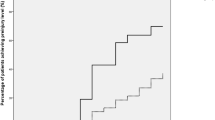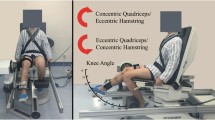Abstract
The aim of the study was to examine whether the peak torque of the hamstring and quadriceps muscles affects the anterior knee laxity measurements in male patients. The study comprised 45 male patients who had a chronic unilateral anterior cruciate ligament (ACL) rupture. Preoperatively, one experienced physiotherapist performed all the KT-1000 examinations. The anterior displacement was registered at 89 Newton. Immediately after the KT-1000 examination, an isokinetic concentric peak torque measurement was performed at 60°/s for both the hamstring and quadriceps muscles. The anterior displacement was significantly larger in the ACL-ruptured knees compared with the noninjured knees (p < 0.001). Patients with strong hamstring muscles on the injured side displayed significantly less knee laxity compared with patients with less strength (p = 0.018). There was an inverse correlation between the peak torque of the hamstring muscles and the KT-1000 anterior laxity measurements in the ACL-ruptured knees (rho = −0.37, p = 0.01). We conclude that male patients with strong hamstring muscles display smaller KT-1000 laxity measurements than patients with less strength.
Similar content being viewed by others
Author information
Authors and Affiliations
Additional information
Received: 22 January 2001/Accepted: 24 January 2001
Rights and permissions
About this article
Cite this article
Sernert, N., Kartus, J., Köhler, K. et al. Does the peak torque of the hamstring and quadriceps muscles affect the knee laxity measurements in male patients with anterior cruciate ligament rupture?. J Orthopaed Traumatol 1, 125–130 (2000). https://doi.org/10.1007/s101950070003
Issue Date:
DOI: https://doi.org/10.1007/s101950070003




